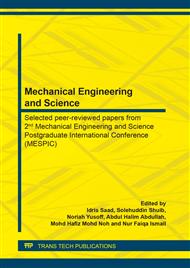[1]
G.M. Whitesides, Bioinspiration: something for every-one, Interface Focus 5. (2015) 20150031.
Google Scholar
[2]
D. J. Pines, F. Bohorquez. Challenges Facing Future Micro-Air-Vehicle Development. Journal of Aircraft. 43:2 (2006), 290-310.
DOI: 10.2514/1.4922
Google Scholar
[3]
I. Gursul, D.J. Cleaver, Z. Wang. Control of Low Reynolds Number Flows by Means of Fluid-Structure Interactions. Progress in Aerospace Sceinces 64 (2015), 17-55.
DOI: 10.1016/j.paerosci.2013.07.004
Google Scholar
[4]
S.M. Swartz, M.S. Groves, H.D. Kim, W.R. Walsh. Mechanical Properties of Bat Wing Membrane Skin. Journal of Zoology. 239 (1996) 357-378.
DOI: 10.1111/j.1469-7998.1996.tb05455.x
Google Scholar
[5]
N. Goulbourne, Y. Wang, S. Son, A. Skulborstad. Microstructure and Material Characterization of Bat Wing Tissue for Active Skin Composites. 18th International Conference On Composite Materials. (2011).
Google Scholar
[6]
H. Yusoff, M. Z. Abdullah, K.A. Ahmad, S. Suhaimi, Experimental Study on the Effect of Skin Flexibility on Aerodynamic Performance of Flapping Wings for Micro Air Vehicles. Ap-plied Mechanics and Materials 696 (2014) 18-23.
DOI: 10.4028/www.scientific.net/amm.629.18
Google Scholar
[7]
H. Yusoff, N. Iswadi, A.H. Zulkifly, S.M. Firdaus, M.Z. Abdullah, S. Suhaimi. Lift Performance of A Cambered Wing for Aerodynamic Performance Enhancement of The Flapping Wing. Jurnal Teknologi. 75;8 (2015) 42-47.
DOI: 10.11113/jt.v75.5208
Google Scholar
[8]
H. Aono, H. Liu. Flapping Wing Aerodynamics of a Numerical Biological Flyer Model in Hovering Flight. Computers and Fluids 85 (2013) 85-92.
DOI: 10.1016/j.compfluid.2012.10.019
Google Scholar
[9]
S. Tobing, J. Young, J.C.S. Lai. Effects of Wing Flexibility on Bumblebee Propulsion. Journal of Fluids and Structures. 68 (2017) 141-157.
DOI: 10.1016/j.jfluidstructs.2016.10.005
Google Scholar
[10]
W.B. Tay. Effect of Different Types of Wing-Wing Interactions in Flapping MAVs. Journal of Bionic Engineering. 14 (2017) 60-74.
DOI: 10.1016/s1672-6529(16)60378-5
Google Scholar
[11]
W.B. Tay. Symmetrical and Non-Symmetrical 3D Wing De-formation of Flapping Micro Aerial Vehicles. Aerospace Science and Technology 55 (2016) 242-251.
DOI: 10.1016/j.ast.2016.05.026
Google Scholar
[12]
G. Jeanmonod, M. Olivier. Effects of Chordwise Flexibility on 2D Flapping Foils Used as an Energy Extraction Device. Journal of Fluids and Structures. 70 (2017) 327-345.
DOI: 10.1016/j.jfluidstructs.2017.01.009
Google Scholar
[13]
S. Shuib, M.I.Z. Ridwan, A.H. Kadarman. Methodology of Compliant Mechanisms and its Current Developments in Ap-plications: A Review. American Journal of Applied Sciences 4(3) (2007) 160-167.
DOI: 10.3844/ajassp.2007.160.167
Google Scholar
[14]
Y. Yu, Z. Guan. Learning From Bat; Aerodynamics of Active-ly Morphing Wing. Theoretical and Applied Mechanics Letters. 5 (2015) 13-15.
DOI: 10.1016/j.taml.2015.01.009
Google Scholar
[15]
T.Y. Hubel, N.I. Hristov, S.M. Swartz, K.S. Breuer. Time-Resolved Wake Structure and Kinematics of Bat Flight. Experimental Fluids. 46:5 (2009) 933-944.
DOI: 10.1007/s00348-009-0624-7
Google Scholar
[16]
S. Wang, X. Zhang, G. He, T. Liu. Numerical Simulation of Unsteady Flow Over a Slow-Flying Bat. Theoretical and Ap-plied Mechanics Letters. 5 (2015) 13-15.J. van der Geer, J.A.J. Hanraads, R.A. Lupton, The art of writing a scientific article, J. Sci. Commun. 163 (2000) 51-59.
DOI: 10.1016/j.taml.2015.01.006
Google Scholar


